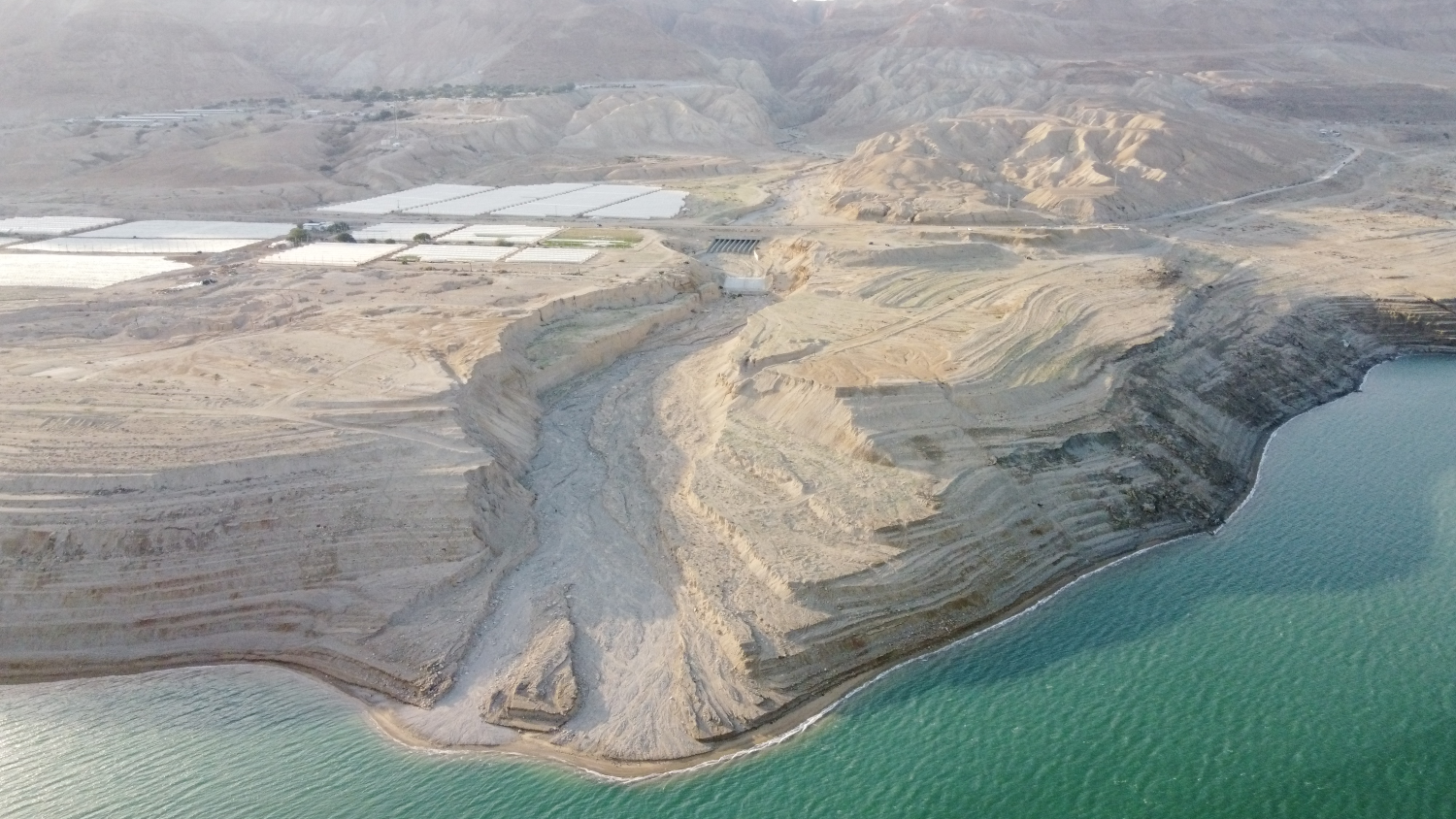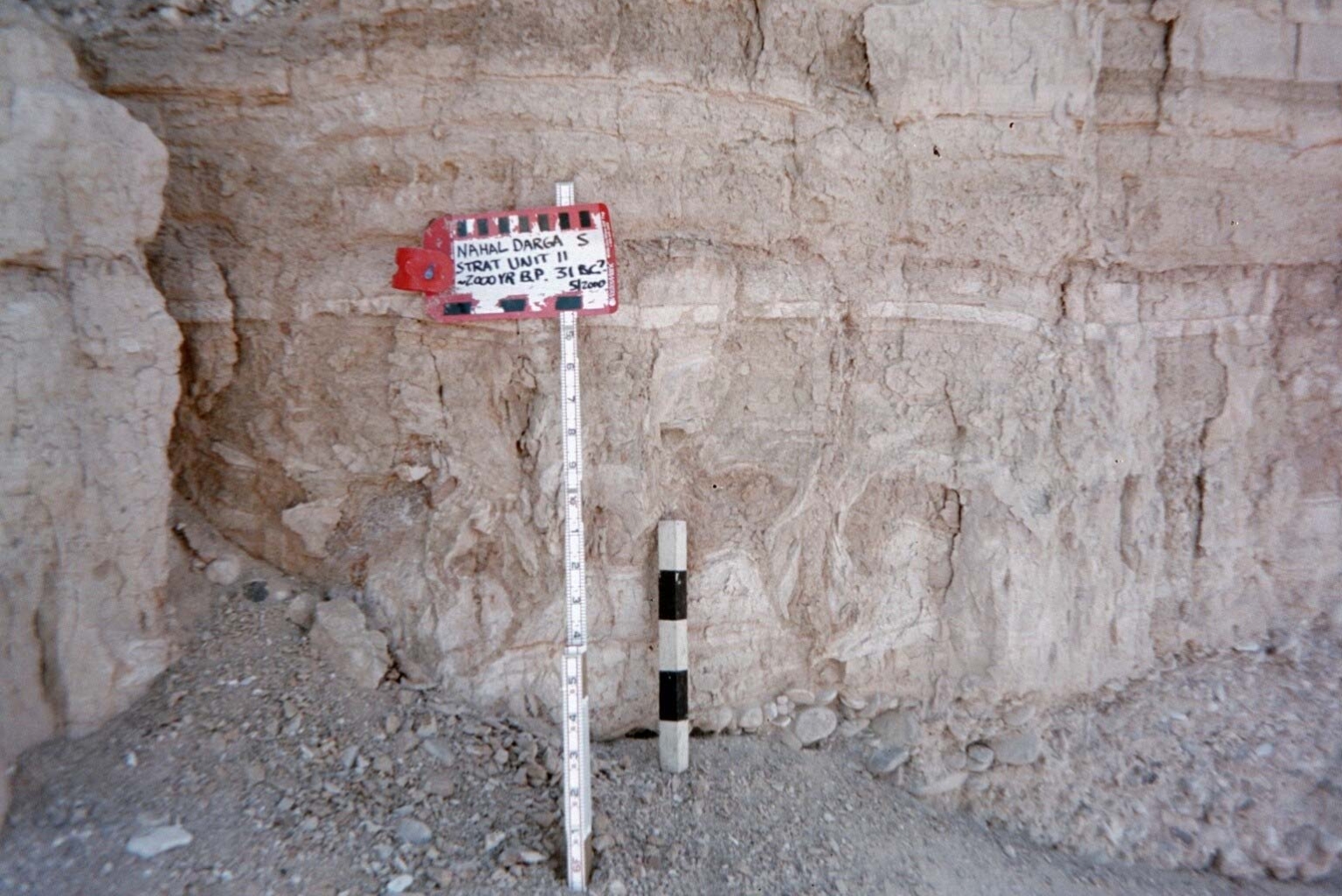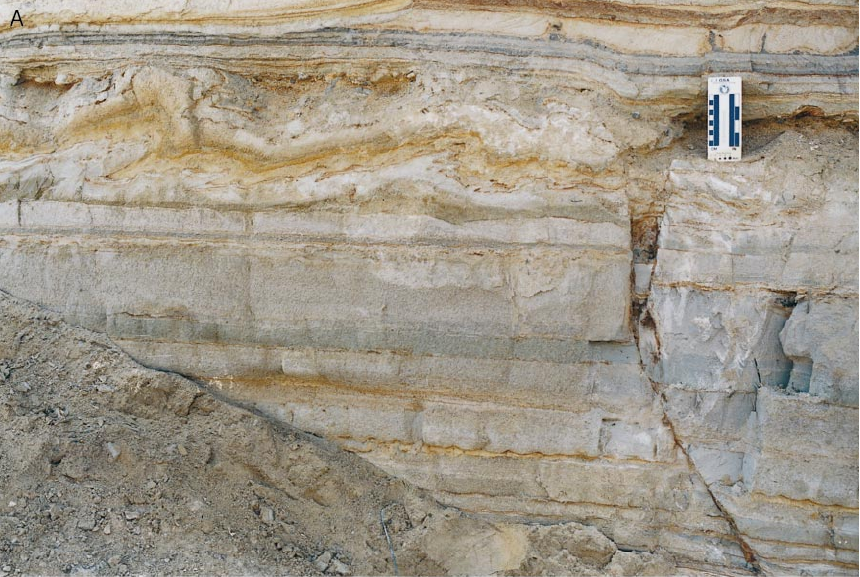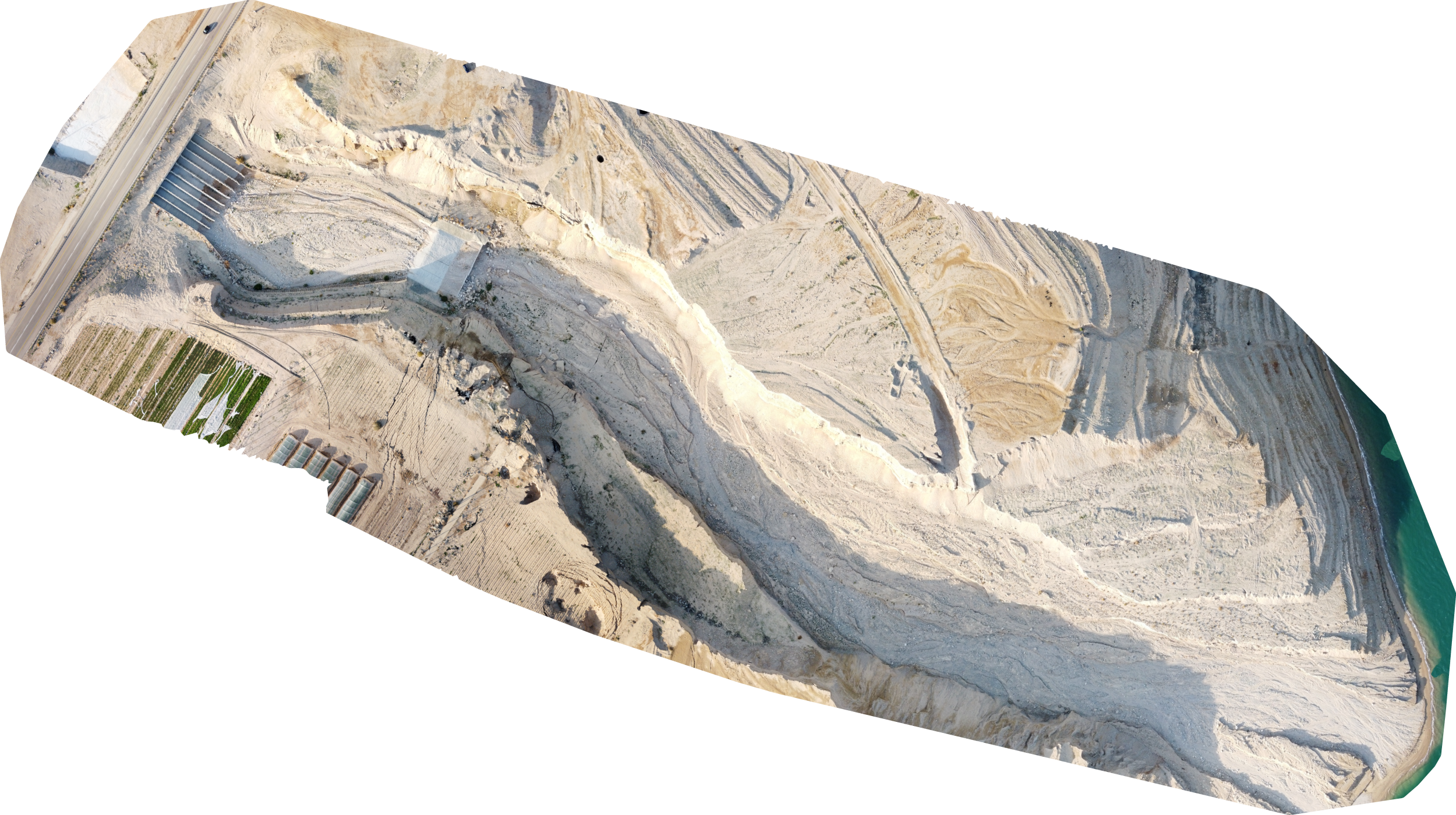Nahal Darga
 Aerial shot of Nahal Darga from the east
Aerial shot of Nahal Darga from the eastClick on Image to open a high resolution magnifiable image in a new tab
Photo by Jefferson Williams 10 Feb. 2023
Maps, Aerial Views, Trench Logs, Deformation Photos, Dip directions plot, and Orthophoto
Maps and Aerial Views
- Fig. 1B Location Map from
Enzel et al (2000)

 Fig. 1B
Fig. 1B
A few active faults in the Dead Sea Area (Garfunkel et al., 1981; ten Brink and Ben-Avraham, 1989; Garfunkel and Ben-Avraham, 1996) and the epicenter of the Jericho 1927 earthquake (M 6.2) and its uncertainty ellipse (Shapira et al., 1993).
Enzel et al (2000) - Fig. 1D Site Map from
Enzel et al (2000)

 Fig. 1D
Fig. 1D
Shorelines of the Dead Sea on late Holocene fan-delta surfaces of Nahal Darga.
Enzel et al (2000) - Aerial Photo of Nahal Darga by JW
- Nahal Darga in Google Earth
- Nahal Darga on govmap.gov.il
Trench Logs
Location Map
 Fig. 1D
Fig. 1DShorelines of the Dead Sea on late Holocene fan-delta surfaces of Nahal Darga.
Enzel et al (2000)
Southern Wall

The stratigraphy of the southern wall (A) of the incised channel (Fig. 1) of Nahal Darga. No vertical exaggeration. The scale at the base of each section is in meters. The left end of each of the five sections is connected to the right end of the section below. Numbers in circles are easily identified field stratigraphic units; each may contain a few to many beds and more than one lithological characteristic. The main lithology is marked. See Table 1 for details of 14C ages.
Legend
- fluvial gravel
- near-shore sand with frequent ripple marks
- well-bedded to laminated clay silt with ocassional aragonite
- well- to medium sorted coarse sand, pebbles and cobbles in sets of the delta front
- well-sorted prograding beach deposits with lenses of clay–silt lagoonal deposits
- the major unconformity in the section; its age is estimated at approximately 4000 yr B.P. (Kadan, 1997)
These maps were produced by logging the walls at specific sites and by mapping with scaled photographs between them
Enzel et al (2000)
Northern Wall

The stratigraphy of the northern wall (B) of the incised channel (Fig. 1) of Nahal Darga. No vertical exaggeration. The scale at the base of each section is in meters. The left end of each of the five sections is connected to the right end of the section below. Numbers in circles are easily identified field stratigraphic units; each may contain a few to many beds and more than one lithological characteristic. The main lithology is marked. See Table 1 for details of 14C ages.
Legend
- fluvial gravel
- near-shore sand with frequent ripple marks
- well-bedded to laminated clay silt with ocassional aragonite
- well- to medium sorted coarse sand, pebbles and cobbles in sets of the delta front
- well-sorted prograding beach deposits with lenses of clay–silt lagoonal deposits
- the major unconformity in the section; its age is estimated at approximately 4000 yr B.P. (Kadan, 1997)
These maps were produced by logging the walls at specific sites and by mapping with scaled photographs between them
Enzel et al (2000)
Closeup of tectonic slump on southern wall
 Fig. 7
Fig. 7Example of a tectonic slump (Fig. 2A, meters 280–290).
Enzel et al (2000)
Western faulted zone of exposed southern wall

Detailed map of the western faulted zone at the southern wall of Nahal Darga (Figs. 2A and 3). The faults show a maximum of three displacements. For example the total vertical displacement of unit 4 on faults D–F is approximately 4.5 m. When the displacement is measured from the two ends of the figure and thickness changes are accounted for the total displacement is 3.5 m. The prograding beach deposits are displaced approximately 3.5 m by faults D–F but with lower total displacement in the entire zone. The units underneath the erosional unconformity (dark solid line) are .7000 yr B.P. Most of these units grade into sand a few tens of meters to the east. The age of the erosional channel and its associated deposits directly above the unconformity is not clear. The age of the unconformity itself is probably 4000 yr B.P. (Kadan, 1997). The top gravel unit is a historical alluvial-fan, which was active between 1900s and the late 1960s. Only minor fractures without any observed displacement cross the unconformity; none reach the surface.
Enzel et al (2000)
Deformation Photos
Faults A and B of exposed southern wall
 Fig. 3
Fig. 3A photograph showing faults A and B of Figure 4 exposed at the southern wall (see Fig. 2A, meters 80–115). Such excellent exposures exist all along the wall of the incised Nahal Darga as it flows from right to left. See Figure 4 for scale and explanations. Note the tilted beds with well-pronounced prograding beach ridge deposits in the middle of the section. The erosional channel parallels the faults and was filled with coarse sandy gravel of unknown age and was truncated and covered by a very thin cap (;0.5 m) by 1960s alluvial-fan deposits.
Enzel et al (2000)
Deformation 10 which occurred 400–500 yr B.P.
 Fig. 6A
Fig. 6ABall and pillow structures from deformation 10 (Table 2) that occurred 400–500 yr B.P.
Enzel et al (2000)
Deformation 9 which occurred 2000 yr B.P. likely due to the Josephus Quake of 31 BCE
 Fig. 6B
Fig. 6BDeformation 9 in Stratigraphic Unit 11 which occurred 2000 yr B.P. likely due to the Josephus Quake of 31 BCE.
Photo by Jefferson Williams in May 2000
Deformation 5 (~8000 yrs B.P.)
 Fig. 5D
Fig. 5DDeformation 5 (Table 2) at approximately 10 m to the west is changing its characteristics. The deformations in this bed have a large variety of forms.
The comparison between 5C and 5D indicates that the gravel in D was deposited much later than the deformation.
Enzel et al (2000)
Deformations 4 (~8000 yrs B.P.) and 5 (~8000 yrs B.P.)
 Fig. 5C
Fig. 5CDeformations 4 (lower) and 5 (upper, with the scale) (Table 2) are separated by a thin undeformed bed. The stratigraphy at left of the photograph indicates that deposition prior to the second deformation was thicker than this thin undeformed bed.
The comparison between 5C and 5D indicates that the gravel in D was deposited much later than the deformation.
Enzel et al (2000)
Deformation 3 (~8000 yrs B.P.)
Wide View
 >Fig. 6B
>Fig. 6BDike-like structure of the underlying layer penetrating the overlying deformed bed (deformation 3, Table 2)
Enzel et al (2000)
Closeup
 Fig. 5B
Fig. 5BExample of part of deformation 3 (Table 2).
Enzel et al (2000)
Deformation 2 (~8000 yrs B.P.)
 Fig. 5A
Fig. 5AThe only fault-related deformation (Table 2, deformation 2). Convoluted laminations next to the minor fault that was active approximately 8000 yr B.P. Load cast are seen a few meters laterally.
Enzel et al (2000)
Dip directions of the measured faults
 Fig. 1C
Fig. 1CDip directions of the measured faults exposed in the Holocene sequence of the fan-delta of Nahal Darga.
Enzel et al (2000)
Master Seismic Events Table
Drone Surveys
| Description | Flight Date | Pilot | Processing | Downloadable Link |
|---|---|---|---|---|
| Nahal Darga | 10 Feb. 2023 | Jefferson Williams | ODM - no GCPs | Right Click to download. Then unzip |


